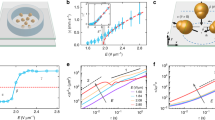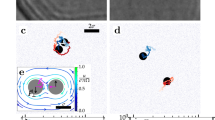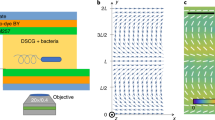Abstract
Spontaneous emergence of correlated states such as flocks and vortices is a prime example of collective dynamics and self-organization observed in active matter1,2,3,4,5,6. In geometrically confined systems, the formation of globally correlated polar states proceeds through the emergence of a macroscopic steadily rotating vortex, which spontaneously selects a clockwise or counterclockwise global chiral state7,8. Here, we reveal that a global vortex formed by colloidal rollers exhibits polar state reversal and that a subsequent formation of the collective states upon re-energizing the system is not random. We combine experiments and simulations to elucidate how a combination of hydrodynamic and electrostatic interactions leads to hidden asymmetries in the local particle positional order, reflecting the chiral state of the system. These asymmetries can be exploited to systematically command subsequent polar states of active liquids through temporal control of the activity.
This is a preview of subscription content, access via your institution
Access options
Access Nature and 54 other Nature Portfolio journals
Get Nature+, our best-value online-access subscription
$29.99 / 30 days
cancel any time
Subscribe to this journal
Receive 12 print issues and online access
$209.00 per year
only $17.42 per issue
Buy this article
- Purchase on Springer Link
- Instant access to full article PDF
Prices may be subject to local taxes which are calculated during checkout




Similar content being viewed by others
Data availability
The raw data supporting the findings of this study are available from the corresponding author upon request. Source data are provided with this paper.
Code availability
All custom codes used for the data processing and numerical modeling are available from the corresponding author upon reasonable request.
References
Vicsek, T. & Zafeiris, A. Collective motion. Phys. Rep. 517, 71–140 (2012).
Marchetti, M. C. et al. Hydrodynamics of soft active matter. Rev. Mod. Phys. 85, 1143–1189 (2013).
Aranson, I. S. Active colloids. Phys.-Usp. 56, 79–92 (2013).
Snezhko, A. Complex collective dynamics of active torque-driven colloids at interfaces. Curr. Opin. Colloid Interface Sci. 21, 65–75 (2016).
Zöttl, A. & Stark, H. Hydrodynamics determines collective motion and phase behavior of active colloids in quasi-two-dimensional confinement. Phys. Rev. Lett. 112, 118101 (2014).
Wu, K.-T. et al. Transition from turbulent to coherent flows in confined three-dimensional active fluids. Science 355, eaal1979 (2017).
Bricard, A. et al. Emergent vortices in populations of colloidal rollers. Nat. Commun. 6, 7470 (2015).
Kaiser, A., Snezhko, A. & Aranson, I. S. Flocking ferromagnetic colloids. Sci. Adv. 3, e1601469 (2017).
Peruani, F. et al. Collective motion and nonequilibrium cluster formation in colonies of gliding bacteria. Phys. Rev. Lett. 108, 098102 (2012).
Schaller, V., Weber, C., Semmrich, C., Frey, E. & Bausch, A. R. Polar patterns of driven filaments. Nature 467, 73–77 (2010).
Sumino, Y. et al. Large-scale vortex lattice emerging from collectively moving microtubules. Nature 483, 448–452 (2012).
Sokolov, A. & Aranson, I. S. Physical properties of collective motion in suspensions of bacteria. Phys. Rev. Lett. 109, 248109 (2012).
Bricard, A., Caussin, J.-B., Desreumaux, N., Dauchot, O. & Bartolo, D. Emergence of macroscopic directed motion in populations of motile colloids. Nature 503, 95–98 (2013).
Yan, J. et al. Reconfiguring active particles by electrostatic imbalance. Nat. Mater. 15, 1095–1099 (2016).
Kokot, G. et al. Active turbulence in a gas of self-assembled spinners. Proc. Natl Acad. Sci. USA 114, 12870–12875 (2017).
Doostmohammadi, A., Ignés-Mullol, J., Yeomans, J. M. & Sagués, F. Active nematics. Nat. Commun. 9, 3246 (2018).
Zhang, B., Sokolov, A. & Snezhko, A. Reconfigurable emergent patterns in active chiral fluids. Nat. Commun. 11, 4401 (2020).
Martin, J. E. & Snezhko, A. Driving self-assembly and emergent dynamics in colloidal suspensions by time-dependent magnetic fields. Rep. Prog. Phys. 76, 126601 (2013).
Driscoll, M. et al. Unstable fronts and motile structures formed by microrollers. Nat. Phys. 13, 375–379 (2017).
Weber, C. A. et al. Long-range ordering of vibrated polar disks. Phys. Rev. Lett. 110, 208001 (2013).
Kokot, G. & Snezhko, A. Manipulation of emergent vortices in swarms of magnetic rollers. Nat. Commun. 9, 2344 (2018).
Massana-Cid, H., Codina, J., Pagonabarraga, I. & Tierno, P. Active apolar doping determines routes to colloidal clusters and gels. Proc. Natl Acad. Sci. USA 115, 10618–10623 (2018).
Han, K. et al. Reconfigurable structure and tunable transport in synchronized active spinner materials. Sci. Adv. 6, eaaz8535 (2020).
Palacci, J., Sacanna, S., Steinberg, A. P., Pine, D. J. & Chaikin, P. M. Living crystals of light-activated colloidal surfers. Science 339, 936–940 (2013).
Quincke, G. Ueber Rotationen im constanten electrischen Felde. Ann. der Phys. 295, 417–486 (1896).
Melcher, J. & Taylor, G. Electrohydrodynamics: a review of the role of interfacial shear stresses. Annu. Rev. fluid Mech. 1, 111–146 (1969).
Das, D. & Saintillan, D. Electrohydrodynamic interaction of spherical particles under Quincke rotation. Phys. Rev. E 87, 043014 (2013).
Pannacci, N., Lobry, L. & Lemaire, E. How insulating particles increase the conductivity of a suspension. Phys. Rev. Lett. 99, 094503 (2007).
Durlofsky, L., Brady, J. F. & Bossis, G. Dynamic simulation of hydrodynamically interacting particles. J. Fluid Mech. 180, 21–49 (1987).
Kim, S. & Karrila, S. J. Microhydrodynamics - Principles and Selected Applications (Dover Publications, 2005).
Brady, J. F. & Bossis, G. Stokesian dynamics. Annu. Rev. Fluid Mech. 20, 111–157 (1988).
Rotne, J. & Prager, S. Variational treatment of hydrodynamic interaction in polymers. J. Chem. Phys. 50, 4831–4837 (1969).
Wajnryb, E., Mizerski, K. A., Zuk, P. J. & Szymczak, P. Generalization of the Rotne–Prager–Yamakawa mobility and shear disturbance tensors. J. Fluid Mech. 731, R3 (2013).
Blake, J. R. A note on the image system for a stokeslet in a no-slip boundary. Math. Proc. Camb. Philos. Soc. 70, 303–310 (1971).
Swan, J. W. & Brady, J. F. Simulation of hydrodynamically interacting particles near a no-slip boundary. Phys. Fluids 19, 113306 (2007).
Balboa Usabiaga, F., Delmotte, B. & Donev, A. Brownian dynamics of confined suspensions of active microrollers. J. Chem. Phys. 146, 134104 (2017).
Jones, T. B. Electromechanics of Particles (Cambridge Univ. Press, 2005).
Sainis, S. K., Germain, V., Mejean, C. O. & Dufresne, E. R. Electrostatic interactions of colloidal particles in nonpolar solvents: role of surface chemistry and charge control agents. Langmuir 24, 1160–1164 (2008).
Ermak, D. L. & McCammon, J. A. Brownian dynamics with hydrodynamic interactions. J. Chem. Phys. 69, 1352–1360 (1978).
Kazoe, Y. & Yoda, M. Measurements of the near-wall hindered diffusion of colloidal particles in the presence of an electric field. Appl. Phys. Lett. 99, 124104 (2021).
Acknowledgements
The research of B.Z., A. Sokolov and A. Snezhko at Argonne National Laboratory was supported by the US Department of Energy, Office of Science, Basic Energy Sciences, Materials Sciences and Engineering Division. Use of the Center for Nanoscale Materials, an Office of Science user facility, was supported by the US Department of Energy, Office of Science, Office of Basic Energy Sciences, under Contract No. DE-AC02-06CH11357. H.Y. and M.O.d.l.C. were supported by the Center for Bio-Inspired Energy Science, an Energy Frontier Research Center funded by the US Department of Energy, Office of Science, Basic Energy Sciences under Award DE-SC0000989.
Author information
Authors and Affiliations
Contributions
A. Snezhko and B.Z. conceived the research. B.Z. performed the experiments. H.Y. and A. Sokolov performed simulations. B.Z., H.Y., A. Sokolov, M.O.d.l.C. and A. Snezhko analysed the data and wrote the manuscript.
Corresponding author
Ethics declarations
Competing interests
The authors declare no competing interests.
Additional information
Peer review information Nature Physics thanks the anonymous reviewers for their contribution to the peer review of this work.
Publisher’s note Springer Nature remains neutral with regard to jurisdictional claims in published maps and institutional affiliations.
Supplementary information
Supplementary Information
Supplementary Figs. 1–8 and Notes 1–3.
Supplementary Video 1
Part 1. Reversal of a roller vortex chiral state in a well induced by a temporal modulation of activity. Left: experimental video of the system. Right: superimposed velocity (arrows) and vorticity (background colour) fields of the rollers during the chiral state reversal. The size of the well D = 1 mm. The area fraction ϕ = 0.12. The total duration is 5 s and the field-off time τoff = 0.5 s. The playback is 0.2× the real time. Part 2. Multiple successive reversals of a vortex chiral state in a well. The size of the well D = 2 mm. The area fraction ϕ = 0.08. The period of 1 cycle is 10 s and τoff = 0.5 s. The total duration is 40 s. The playback is 2× the real time.
Supplementary Video 2
Time evolution of tangential roller velocities in the course of one chirality reversal event. Rollers are shown as circles coloured according to the magnitude of the tangential velocity vt. The size of the well D = 1 mm. The area fraction ϕ = 0.12. The total duration is 4.9 s and the field-off time τoff = 0.5 s. The playback is 0.2× the real time.
Supplementary Video 3
Part 1. Reversal of a chiral state in a track on a temporal modulation of activity. The outer diameter of the track D = 2 mm and the width W = 0.25 mm. The area fraction ϕ = 0.12. The total duration is 5 s and the field-off time τoff = 0.5 s. The playback is 0.2× the real time. Part 2. Multiple successive reversals of a vortex chiral state in a track. The outer diameter of the track D = 2 mm and the width W = 0.25 mm. The period of 1 cycle is 10 s and τoff = 0.5 s. The total duration is 100 s. The playback is 2× the real time. Part 3. Multiple successive reversals of a vortex chiral state in an elongated track. The length of the track L = 10 mm. The outer diameter D = 2 mm. The width W = 0.5 mm. The period of 1 cycle is 10 s andτoff = 0.5 s. The total duration is 50 s. The playback is 2× the real time.
Supplementary Video 4
Multiple successive reversals of chiral states in wells by the particle-based simulations under three different scenarios. Scenario a-both electrostatic and hydrodynamic interactions between rollers are included in the model. Scenario b-only hydrodynamic interactions drive roller dynamics and Scenario c-only electrostatic interactions contribute to the dynamics. Red arrows indicate the directions of particle velocities and yellow arrows show the in-plane components of the dipoles. The size of the well D = 1 mm. The area fraction ϕ = 0.10. The period of one cycle is 5.25 s for Scenarios a and b and 15.25 s for Scenario c. The field-off time τoff = 0.25 s. The total duration is 15 s for Scenarios a and b and 45 s for Scenario c. The playback is 0.5× the real time for Scenarios a and b and 1.5× for Scenario c.
Supplementary Video 5
Time evolution of tangential roller velocities during a chirality reversal as obtained in simulations for a vortex in a well under Scenario a. Rollers are shown as circles coloured according to the magnitude of the tangential velocity vt. The size of the well D = 1 mm. The area fraction ϕ = 0.10. The total duration is 5.25 s and the field-off time τoff = 0.25 s. The playback is 0.2× the real time.
Supplementary Video 6
Part 1. Competition of multiple flocks in experiments. The playback is 0.25× the real time. Part 2. Competition of multiple flocks in simulations. The playback is 0.25× the real time.
Supplementary Video 7
Time evolution of tangential velocities of particles in the course of the chirality reversal for a vortex in a well as described by the phenomenological minimalistic model. Particles are shown as circles coloured according to the magnitude of the tangential velocity vt.
Supplementary Video 8
Part 1. Multiple successive reversals of a chiral vortex in a confined droplet. The size of the droplet D = 1.8 mm. The period of 1 cycle is 10 s and the field-off time τoff = 0.5 s. The total duration is 40 s. The playback is 2× the real time. Part 2. Multiple successive simultaneous reversals of two chiral vortices in two confined droplets. Two vortices have opposite chiralities. The total duration is 50 s. The playback is 2× the real time.
Supplementary Video 9
Multiple successive reversals of a chiral vortex under non-circular confinement. The period of 1 cycle is 10 s and the field-off time τoff = 1 s. The total duration is 30 s. The playback is 1× the real time.
Source data
Source Data Fig. 1
Source data for all subfigures in Fig. 1.
Source Data Fig. 2
Source data for all subfigures in Fig. 2.
Source Data Fig. 3
Source data for all subfigures in Fig. 3.
Source Data Fig. 4
Source data for all subfigures in Fig. 4.
Rights and permissions
About this article
Cite this article
Zhang, B., Yuan, H., Sokolov, A. et al. Polar state reversal in active fluids. Nat. Phys. 18, 154–159 (2022). https://doi.org/10.1038/s41567-021-01442-6
Received:
Accepted:
Published:
Issue Date:
DOI: https://doi.org/10.1038/s41567-021-01442-6
This article is cited by
-
Spontaneous shock waves in pulse-stimulated flocks of Quincke rollers
Nature Communications (2023)
-
Diffusive regimes in a two-dimensional chiral fluid
Communications Physics (2022)



